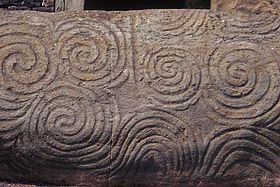Irish art: Difference between revisions
| Line 95: | Line 95: | ||
* Bruce Arnold (1977). ''Irish Art: A Concise History''. London: Thames & Hudson. ISBN 0-500-20148-X |
* Bruce Arnold (1977). ''Irish Art: A Concise History''. London: Thames & Hudson. ISBN 0-500-20148-X |
||
[http://www.royburnsirishart.com Irish Art by ROY BURNS.]==External links== |
*[http://www.royburnsirishart.com Irish Art by ROY BURNS.]==External links== |
||
*[http://www.artscouncil.ie/ The Irish Arts Council] |
*[http://www.artscouncil.ie/ The Irish Arts Council] |
||
*[http://www.ncad.ie/nival The National Irish Visual Arts Library] |
*[http://www.ncad.ie/nival The National Irish Visual Arts Library] |
||
Revision as of 16:34, 14 February 2008

The early history of Irish visual art is generally considered to begin with early carvings found at sites such as Newgrange and is traced through Bronze Age artifacts, particularly ornamental gold objects, and the religious carvings and illuminated manuscripts of the medieval period. During the course of the 19th and 20th centuries, a strong indigenous tradition of painting emerged, including such figures as John Butler Yeats, William Orpen and Jack Yeats.
Ireland's best known living artists include Louis le Brocquy, a figurative painter and print maker, Sean Scully an abstract expressionist who lives and works in New York, Dorothy Cross, a sculptor and filmmaker and James Coleman, an installation and video artist.
Interest in collecting Irish art has expanded rapidly with the economic expansion of the country, primarily focussing on investment in early twentieth century painters. Support for young Irish artists is still relatively minor compared to their European counterparts, as the Arts Council's focus has been on improving infrastructure and professionalism in venues. That said, Ireland's unique tax break for creative artists (writers, visual artists and composers) has encouraged a wide community of artists to remain in Ireland.
Early Irish art

Celtic art
In Ireland an unbroken Celtic heritage existed from before and through the Roman period in Britain, which had never reached the island, and thus the 5th to 7th centuries were mainly a continuation of the late Iron Age La Tène traditions, with only some minor Roman influences. In the 7th and 8th centuries Irish art mixed with Germanic traditions through Irish missionary contacts with the Anglo-Saxons, creating what is called Insular art (or the Hiberno-Saxon style) and such masterpieces as the Book of Kells, the Ardagh Chalice and the Tara Brooch. Later in the period Scandinavian influences were added through the Vikings, then original Celtic work came to an end with the Norman invasion in 1169-1170 and subsequent introduction of Romanesque art.
Towards an Irish art
Due to ongoing wars, occupation and poverty much of the Irish arts were restricted to music and literature. Yet beginning in the late 17th century, Irish painting began to take foothold. These painters typically looked outside of Ireland for influence, training and clients who were wealthy enough to afford the purchase of art. For example, Walter Frederick Osborne developed his open air painting in France whereas Sir William Orpen studied in London.
In the second half of the 19th century a climate of cultural resurgence and nationalist ideals contributed to the development of an Irish style. A revived interest in the Irish language and celtic history prompted a revival in the Irish visual arts as well. Belfast born Sir John Lavery may be the most internationally-known painter of this generation. He trained in Glasgow and France, but unlike Orpen, maintained close ties to his native land. In 1928 he was commissioned to paint the symbol of Éire which would be used as the central image on the bank note of the new Irish Free State. Other paintings embodied the call for independence, such as Beatrice Elvery's Éire of 1907 which depicts the history of Irish Catholicism with the still-nascent Irish Republic.[1]
Early Irish masters
The Irish impressionists
The Irish landscape
The Academy
Jack Yeats
Social realism
The Stainglass movement
Modern art
Modernism
- Mainie Jellett
- The White Stag group
- The Exhibition of Living Art
- Louis le Brocquy
- Patrick Scott
- John Kingerlee
Abstract expressionism
The northern artists
Politics
Public art
Contemporary art
See also
References
- Bruce Arnold (1977). Irish Art: A Concise History. London: Thames & Hudson. ISBN 0-500-20148-X
- Irish Art by ROY BURNS.==External links==
- The Irish Arts Council
- The National Irish Visual Arts Library
- www.irishabroad.com A series of essays on Irish art.
- www.modernart.ie Irish Museum of Modern Art.
- Commercial online art gallery specializing in Irish Art
- Commercial online art gallery specializing in Irish Art
- FREE directory for Irish Artists and Art Galleries
- Online Irish Art Competition
- Irish Contemporary Artists
- Irish Landscapes - paintings and prints on canvas
- Irish Traditional and Contemporary Works of Art
